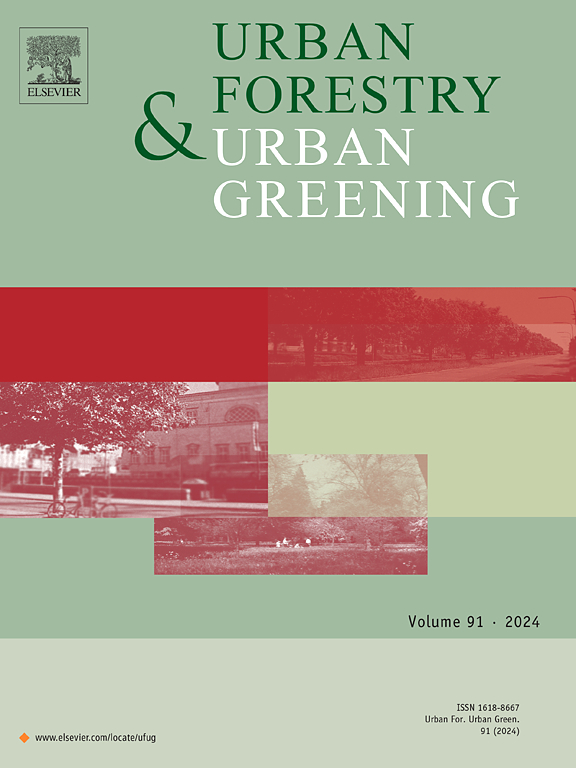A dynamic assessment for greenness exposure and socioeconomic drivers: Evidence from 314 Chinese cities (2000–2020)
IF 6
2区 环境科学与生态学
Q1 ENVIRONMENTAL STUDIES
引用次数: 0
Abstract
Equitable access to urban green spaces is crucial for the physical and mental health of urban residents, the social equity of cities, and their sustainable development. However, rapid urbanization has led to a series of ecological challenges, including land use changes and reductions in green space, which have progressively worsened the uneven distribution of green spaces. While much of the existing research has focused on measuring greenness exposure or accessibility, less attention has been given to the dynamic assessment of equity and its socioeconomic drivers. To address this gap, this study investigates the dynamics of greenness exposure and its inequality (Gini index) in Chinese cities from 2000 to 2020, utilizing vegetation index products. We also explore the correlation between various socioeconomic factors and the disparity in greenness exposure, both across cities and within cities—specifically between city centers and suburban areas. Our findings reveal a notable recovery in greenness exposure between 2010 and 2020, following a decline from 2000 to 2010, with significant improvements observed in larger cities such as Mega and Extra-large cities. Despite this, inequality in green exposure has increased over time, with the Gini index rising from 0.083 in 2000–0.11 in 2010 and 0.13 in 2020. Regression analysis further indicates that a 1 % increase in built-up area leads to a 0.01 %–0.05 % decline in greenness exposure, while higher residential density and urban complexity contribute significantly to widening disparities. Furthermore, restrictions on building height and the reduction of urban heat, along with appropriate urban planning, have been shown to improve residents’ access to green spaces. This research underscores the importance of integrating green spaces into urban planning to ensure equitable access and enhance the sustainability of urban environments. By examining the dynamics of greenness exposure and its potential drivers, this study provides valuable insights for policymakers and urban planners aiming to create more livable and equitable urban spaces.
绿色暴露与社会经济驱动因素的动态评估:来自中国314个城市的证据(2000-2020年)
城市绿地的公平使用对城市居民的身心健康、城市的社会公平及其可持续发展至关重要。然而,快速的城市化带来了一系列生态挑战,包括土地利用的变化和绿地的减少,这些挑战日益加剧了绿地分布的不均匀性。虽然现有的研究大多侧重于测量绿色暴露或可及性,但对公平及其社会经济驱动因素的动态评估的关注较少。为了解决这一差距,本研究利用植被指数产品,研究了2000 - 2020年中国城市绿化暴露的动态及其不平等(基尼指数)。我们还探讨了不同社会经济因素与城市间和城市内(特别是城市中心和郊区)绿化暴露差异之间的相关性。我们的研究结果显示,在经历了2000年至2010年的下降之后,2010年至2020年期间,绿化暴露率出现了显著回升,特大城市和特大城市等大城市的绿化暴露率有了显著改善。尽管如此,绿色暴露的不平等随着时间的推移而加剧,基尼系数从2000年的0.083上升到2010年的0.11和2020年的0.13。回归分析进一步表明,建成区面积每增加1 %,绿地暴露度下降0.01 % ~ 0.05 %,而较高的居住密度和城市复杂性对差距的扩大起着重要作用。此外,对建筑高度的限制和城市热量的减少,以及适当的城市规划,已被证明可以改善居民进入绿色空间的机会。这项研究强调了将绿色空间纳入城市规划的重要性,以确保城市环境的公平获取和增强可持续性。通过研究绿色暴露的动态及其潜在驱动因素,本研究为旨在创造更宜居和公平的城市空间的政策制定者和城市规划者提供了有价值的见解。
本文章由计算机程序翻译,如有差异,请以英文原文为准。
求助全文
约1分钟内获得全文
求助全文
来源期刊

Urban Forestry & Urban Greening
FORESTRY-
CiteScore
11.70
自引率
12.50%
发文量
289
审稿时长
70 days
期刊介绍:
Urban Forestry and Urban Greening is a refereed, international journal aimed at presenting high-quality research with urban and peri-urban woody and non-woody vegetation and its use, planning, design, establishment and management as its main topics. Urban Forestry and Urban Greening concentrates on all tree-dominated (as joint together in the urban forest) as well as other green resources in and around urban areas, such as woodlands, public and private urban parks and gardens, urban nature areas, street tree and square plantations, botanical gardens and cemeteries.
The journal welcomes basic and applied research papers, as well as review papers and short communications. Contributions should focus on one or more of the following aspects:
-Form and functions of urban forests and other vegetation, including aspects of urban ecology.
-Policy-making, planning and design related to urban forests and other vegetation.
-Selection and establishment of tree resources and other vegetation for urban environments.
-Management of urban forests and other vegetation.
Original contributions of a high academic standard are invited from a wide range of disciplines and fields, including forestry, biology, horticulture, arboriculture, landscape ecology, pathology, soil science, hydrology, landscape architecture, landscape planning, urban planning and design, economics, sociology, environmental psychology, public health, and education.
 求助内容:
求助内容: 应助结果提醒方式:
应助结果提醒方式:


